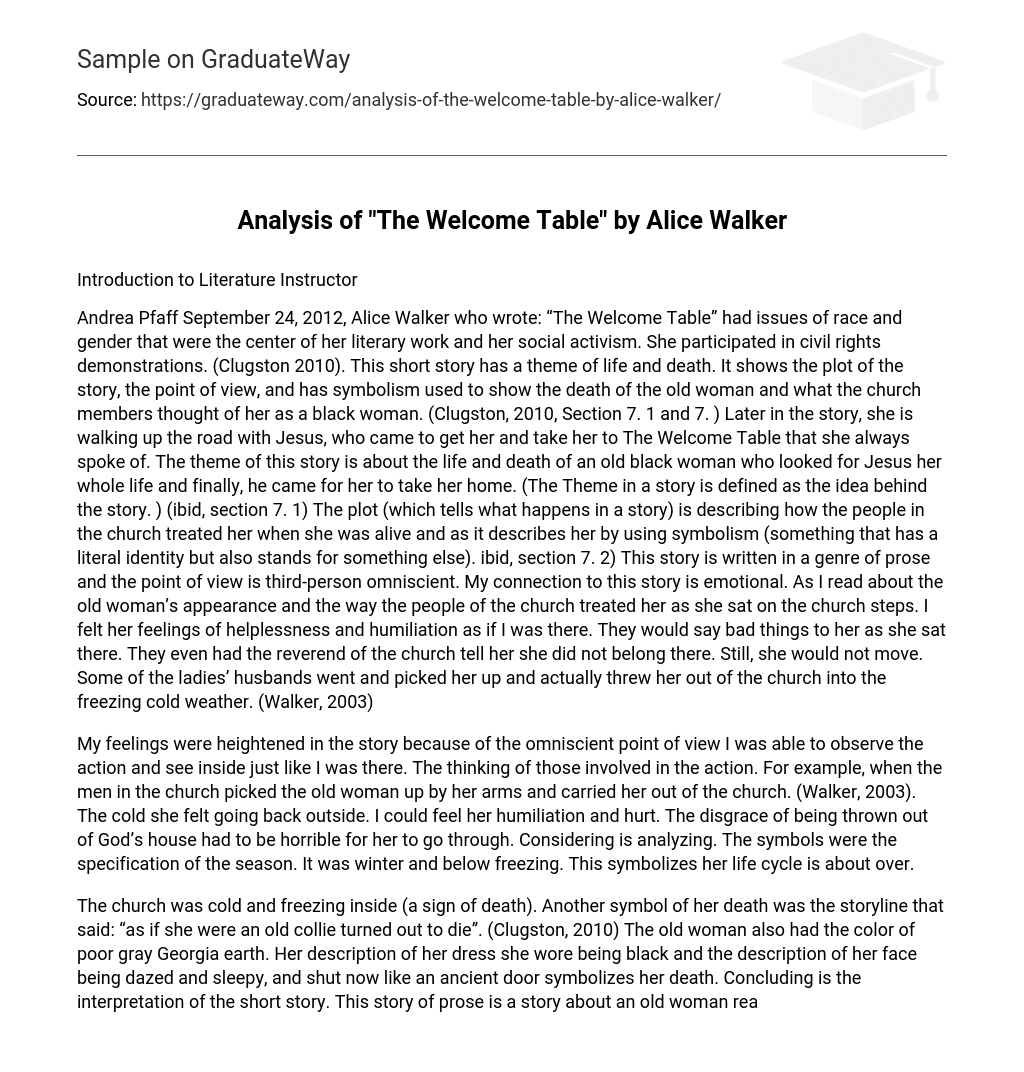Alice Walker who wrote: “The Welcome Table” had issues of race and gender that were the center of her literary work and her social activism. She participated in civil rights demonstrations. (Clugston 2010). This short story has a theme of life and death. It shows the plot of the story, the point of view, and has symbolism used to show the death of the old woman and what the church members thought of her as a black woman. (Clugston, 2010, Section 7. 1 and 7. )
Later in the story, she is walking up the road with Jesus, who came to get her and take her to The Welcome Table that she always spoke of. The theme of this story is about the life and death of an old black woman who looked for Jesus her whole life and finally, he came for her to take her home. (The Theme in a story is defined as the idea behind the story. ) (ibid, section 7. 1)
The plot (which tells what happens in a story) is describing how the people in the church treated her when she was alive and as it describes her by using symbolism (something that has a literal identity but also stands for something else). ibid, section 7. 2) This story is written in a genre of prose and the point of view is third-person omniscient.
My connection to this story is emotional. As I read about the old woman’s appearance and the way the people of the church treated her as she sat on the church steps. I felt her feelings of helplessness and humiliation as if I was there. They would say bad things to her as she sat there. They even had the reverend of the church tell her she did not belong there. Still, she would not move. Some of the ladies’ husbands went and picked her up and actually threw her out of the church into the freezing cold weather. (Walker, 2003)
My feelings were heightened in the story because of the omniscient point of view I was able to observe the action and see inside just like I was there. The thinking of those involved in the action. For example, when the men in the church picked the old woman up by her arms and carried her out of the church. (Walker, 2003). The cold she felt going back outside. I could feel her humiliation and hurt. The disgrace of being thrown out of God’s house had to be horrible for her to go through. Considering is analyzing. The symbols were the specification of the season. It was winter and below freezing. This symbolizes her life cycle is about over.
The church was cold and freezing inside (a sign of death). Another symbol of her death was the storyline that said: “as if she were an old collie turned out to die”. (Clugston, 2010) The old woman also had the color of poor gray Georgia earth. Her description of her dress she wore being black and the description of her face being dazed and sleepy, and shut now like an ancient door symbolizes her death. Concluding is the interpretation of the short story. This story of prose is a story about an old woman ready to die and as she makes her last visit to the church she only gazes up at the sky and she has nothing to say.
She is unwanted by the church congregation and they make it known by throwing her outside in the cold. She only looks up and down the street and sees Jesus coming for her. The tone of this story indicates that she is still alive throughout the church scene until she is outside and sees Jesus. Then the tone changes and reality sets in. She has, in fact, passed away and Jesus is coming for her and takes her home with him. The protagonist is the old woman who never says a word until she is walking down the road with Jesus. She dances and sings and rejoices.
In the beginning, she stated that she would “walk and talk with Jesus; Tell God how you treat me; one of these days! ” (Clugston, 2010). This is meant for the people who treated her badly throughout her life and particularly the church members. They treated her with disrespect, disgust, and unfriendly faces that should not happen in God’s house.
This short story is about an old woman’s life and death. Her unhappy and hard life as a black woman was symbolized by the way she went to the church for her last time. Her treatment by the church members was sad but expected by her because of the way she had been treated throughout her life. Her meeting with Jesus was something she had looked forward to for a long time. He carried her a blanket to keep her warm on her walk to the Welcome Table with him.
References
- Clugston, R. Wayne, Journey into Literature, Section 7. 1 and 7. 2, Bridgepoint Education 2010, www.bridgepointeducation.com
- Walker, Alice. “THE WELCOME TABLE”. Literary Cavalcade 55, no. 5 (February 2003): 32. Academic Search Premier, EBSCOhost (accessed September 25, 2012).
- Chicago/Turabian: Humanities Walker, A, 2003, ‘THE WELCOME TABLE’, Harvard, Literary Cavalcade, 55, 5, p. 32, Academic Search Premier, EBSCOhost, viewed 25 September 2012.





